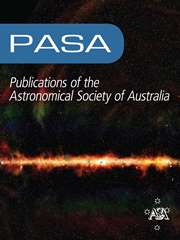Article contents
Solar Neighbourhood Age–Metallicity Relation Based on Hipparcos Data
Published online by Cambridge University Press: 05 March 2013
Abstract
We derive age–metallicity relations (AMRs) and orbits for the 1658 solar neighbourhood stars for which accurate distances are measured by the Hipparcos satellite. The sample comprises 1382 thin disk stars, 229 thick disk stars, and 47 halo stars according to their orbital parameters. We find a considerable scatter for thin disk AMRs along the one-zone Galactic chemical evolution (GCE) model. Orbits and metallicities of thin disk stars show no clear relation to each other. The scatter along the AMR exists even if stars with the same orbits are selected. We examine simple extensions of one-zone GCE models which account for inhomogeneity in the effective yield and inhomogeneous star formation rate in the Galaxy. Both extensions of the one-zone GCE model cannot account for the scatter in the age–[Fe/H]–[Ca/Fe] relation simultaneously. We conclude, therefore, that the scatter along the thin disk AMR is an essential feature in the formation and evolution of the Galaxy. The AMR for thick disk stars shows that star formation terminated 8 Gyr ago in the thick disk. As previously reported, thick disk stars are more Ca-rich than thin disk stars with the same [Fe/H]. We find that thick disk stars show a vertical abundance gradient. These three facts — AMR, vertical gradient, and [Ca/Fe]–[Fe/H] relation — support monolithic collapse and/or accretion of satellite dwarf galaxies as likely thick disk formation scenarios.
Keywords
Information
- Type
- Research Article
- Information
- Publications of the Astronomical Society of Australia , Volume 21 , Issue 2: The Fifth Workshop on Galactic Chemodynamics , 2004 , pp. 121 - 125
- Copyright
- Copyright © Astronomical Society of Australia 2004
References
- 3
- Cited by

